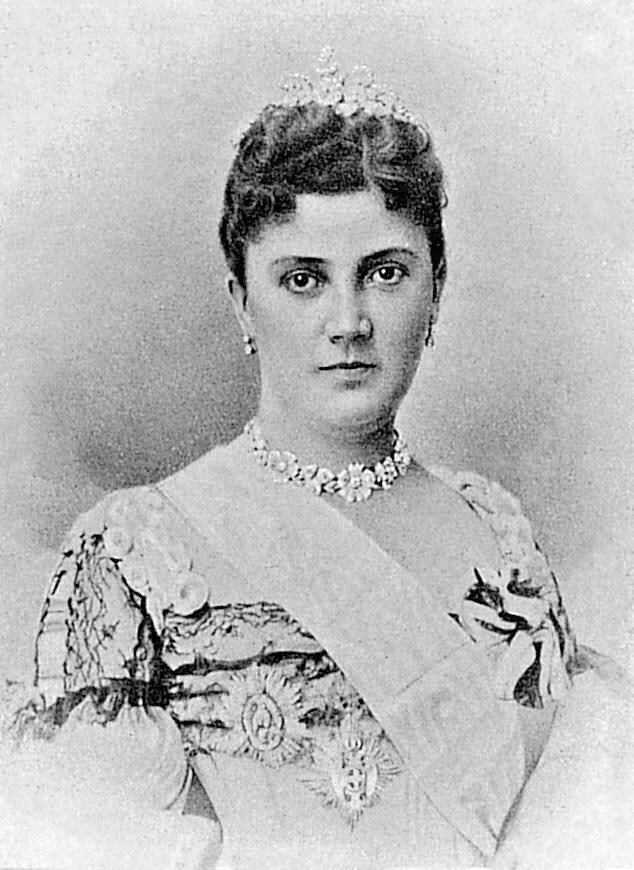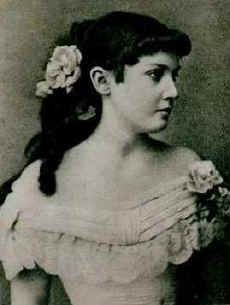by Susan Flantzer © Unofficial Royalty 2019

Draga Mašin, Queen of Serbia; Credit – Wikipedia
Draga Mašin was the wife of King Alexander I of Serbia, the last ruler of Serbia from the House of Obrenović. Alexander’s reign ended with his and Draga’s brutal assassinations. Born Draga Lunjevica on September 23, 1864, in Gornji Milanovac, Serbia, she was the fourth of the five daughters and the sixth of the seven children of Panta Lunjevica and Anđelija Koljević. Panta Lunjevica supported the House of Obrenović and served as a high government administrative official. Draga had two brothers: Nikola and Nikodije and four sisters: Hristina, Đina, Ana, and Vojka.
At the age of nine, Draga was sent to Belgrade, the capital of Serbia, to attend school. There she completed her elementary and secondary education and then attended the Women’s Institute. She learned several foreign languages, including Russian, French, and German. While in Belgrade, Draga began writing novels and short stories. Even though her father was wealthy enough to support her, Draga started to earn her own money. She translated books for money and had stories published in foreign magazines.

A young Draga; Credit – Wikipedia
After Draga completed her education, her parents began to prepare for her marriage. Their choice of a husband for Draga was Svetozar Mašin, a close friend of Draga’s father and a well-known mining engineer, thirteen years older than his intended bride. Svetozar’s father was a respected physician and had served in the court of two Obrenović rulers Prince Mihailo Obrenović III and King Milan I of Serbia, then the current ruler. Draga and Svetozar Mašin were married on August 28, 1883, at the Parliamentary Church in Belgrade.
Because Draga’s husband was a friend of King Milan I of Serbia, Draga was often at court and became acquainted with many people, including Queen Natalija, King Milan’s wife. Draga and Svetozar’s marriage lasted only three years. On May 21, 1886, 35-year-old Svetozar Mašin died from a heart attack, according to a doctor’s report. Draga inherited Svetozar’s pension and his name. Svetozar’s brother, Alexander Mašin, an army officer, was so opposed to this that he later accused Draga of killing his brother and became one of the conspirators in the plot that assassinated Draga and her second husband, King Alexander I of Serbia.
After her husband’s death, Draga continued to write novels and short stories and do translations. She was an editor of the magazine “Housewife” and a member of the Serbian Journalist Society. Draga lived in her husband’s state-owned apartment until she was forced to move out. Both her parents died, making Draga’s financial situation difficult. She tried to arrange a marriage for herself, but to no avail.

Queen Natalija; Credit – Wikipedia
In 1888, King Milan I of Serbia and his wife Queen Natalija divorced. Queen Natalija bought the Villa Sasino in Biarritz, France. Since Queen Natalija was acquainted with Draga, she invited Draga to join her and become her lady-in-waiting. They traveled together by train to Russia, visited Alexander III, Emperor of All Russia, and his family, and then traveled to Biarritz, the spa resort on the Bay of Biscay, on the Atlantic coast of France. In Biarritz, Draga accompanied Queen Natalija to various social events and took care of her wardrobe, jewelry, and cosmetics.

King Alexander I of Serbia, 1894; Credit – Wikipedia
In 1889, King Milan I suddenly abdicated the throne without an apparent reason, and his twelve-year-old son Alexander became king. Several years later, in March 1895, Queen Natalija’s 18-year-old King Alexander I of Serbia arrived in Biarritz. After Draga saved King Alexander from drowning, Draga and Alexander began to see each other. Queen Natalija did not object to Alexander having an affair with Draga, who was twelve years older than Alexander, because she wanted her son ready for marriage to a high-ranking princess. However, the love that developed between Alexander and Draga was much stronger than Alexander’s parents thought. Alexander asked his mother to return to Belgrade and leave him alone with Draga. Queen Natalija did so, thinking it was just a passing adventure. Alexander tried to persuade Draga to leave his mother’s service, saying he would take care of her and her family. However, Draga remained in the service of Queen Natalija until 1897, when she returned to Belgrade.
In Belgrade, many knew about the affair between Alexander and Draga. Draga appeared at every important court function and was praised for her tact, elegance, beauty, wit, and restraint. However, people also thought that it was just an affair. On July 8, 1900, 24-year-old King Alexander suddenly announced his engagement to 36-year-old Draga. The proposed marriage was met with shock and great opposition. Draga was of unequal birth, but more importantly, since Alexander was an only child, he needed to have a child to secure the succession, and there were doubts that Draga could provide an heir.

Alexander and Draga; Credit – Wikipedia
Alexander’s father Milan was out of the country and making arrangements for the marriage of Alexander to Princess Alexandra of Schaumburg-Lippe. Prime Minister Vladan Đorđević was visiting the Paris Universal Exhibition at the time of the announcement. Milan and Đorđević immediately resigned their positions, and Alexander had difficulty forming a new cabinet. Alexander’s mother also opposed the marriage and was subsequently banished from the kingdom along with Alexander’s father, who died the following year from pneumonia in Vienna.
On August 5, 1900, King Alexander married Draga at St. Michael’s Cathedral in Belgrade, Serbia. On the morning of the wedding, thousands of people appeared at Draga’s house, calling out to her. King Alexander wore a military uniform with epaulets and decorations, and Draga wore a white lace wedding dress with a brilliant diadem on her head. Two metropolitans, several bishops, and twenty-six archimandrites performed the Serbian Orthodox wedding ceremony. After the wedding, upon leaving the church, the people shouted, “Long live the King! Long live the Queen!”
On May 8, 1901, King Alexander announced that Queen Draga was pregnant and that Serbia would soon have an heir to the throne. However, it soon became apparent that Queen Draga was not pregnant. Whether Draga deliberately told a lie about being pregnant or whether she was the victim of a delusion by a doctor is not known. The incident completely undermined the reputation of King Alexander and Queen Draga.

Queen Draga; Credit – Wikipedia
On March 25, 1903, irritated by the independence of the Senate and the Council of State, King Alexander suspended the constitution for thirty minutes, enough time to publish decrees dismissing and replacing the members of the Senate and the Council of State. This act greatly increased dissatisfaction in the country. In addition, the Serbian Government had decided to proclaim Prince Mirko of Montenegro, who was married to Natalija Konstantinovic, the granddaughter of Princess Anka Obrenović, an aunt of King Milan, as heir-presumptive to the Serbian throne, but King Alexander had his own ideas. Rumors began to circulate that Nikodije Lunjevica, one of the two unpopular brothers of Queen Draga, was to be proclaimed heir presumptive to the throne.
The army had had enough. A conspiracy, the May Coup, was organized by the military to replace King Alexander I of the House of Obrenović with Prince Peter Karađorđević of the rival House of Karađorđević, Serbia still used the Julian Calendar (Old Style) which was behind the Gregorian Calendar (New Style) that most other countries were using. The coup occurred on the night of May 28-29 Old Style (hence the May Coup) but on the night of June 10-11 New Style.

Illustration of the assassination from an Italian newspaper; Credit – Wikipedia
King Alexander, aged 26, and Queen Draga, aged 38, were brutally shot, mutilated, and thrown out a window at the Stari Dvor (Old Palace), the royal residence of the House of Obrenović, which now houses the City Assembly of Belgrade, Serbia. Queen Draga’s two brothers, Nikodije and Nikola Lunjevica, were executed by a firing squad on the same day. Draga and her husband were secretly buried at St. Mark’s Church in Belgrade, Serbia. The assassination resulted in the extinction of the House of Obrenović. Prince Peter Karađorđević was then proclaimed as the new King of Serbia, and the House of Karađorđević reigned until the monarchy was abolished in 1945.
Embed from Getty Images
The graves of King Alexander I of Serbia and his wife Queen Draga at St. Mark’s Church in Belgrade, Serbia
This article is the intellectual property of Unofficial Royalty and is NOT TO BE COPIED, EDITED, OR POSTED IN ANY FORM ON ANOTHER WEBSITE under any circumstances. It is permissible to use a link that directs to Unofficial Royalty.
Serbia/Yugoslavia Resources at Unofficial Royalty
- Kingdoms of Serbia/Serbs, Croats, and Slovenes/Yugoslavia Index
- Serbian/Yugoslavian Royal Burial Sites
- Profiles: Serbian/Yugoslavian Kings and Consorts
- Rulers of Serbia and Yugoslavia
- Serbian/Yugoslavian Royal Dates
Works Cited
- En.wikipedia.org. (2019). Draga Mašin. [online] Available at: https://en.wikipedia.org/wiki/Draga_Ma%C5%A1in [Accessed 10 Nov. 2019].
- Flantzer, Susan. (2019). King Alexander I of Serbia. [online] Unofficial Royalty. Available at: https://www.unofficialroyalty.com/king-alexander-i-of-serbia/ [Accessed 10 Nov. 2019].
- Ru.wikipedia.org. (2019). Драга Обренович. [online] Available at: https://ru.wikipedia.org/wiki/%D0%94%D1%80%D0%B0%D0%B3%D0%B0_%D0%9E%D0%B1%D1%80%D0%B5%D0%BD%D0%BE%D0%B2%D0%B8%D1%87 [Accessed 10 Nov. 2019].
- Sr.wikipedia.org. (2019). Драга Обреновић. [online] Available at: https://sr.wikipedia.org/wiki/%D0%94%D1%80%D0%B0%D0%B3%D0%B0_%D0%9E%D0%B1%D1%80%D0%B5%D0%BD%D0%BE%D0%B2%D0%B8%D1%9B [Accessed 10 Nov. 2019].
